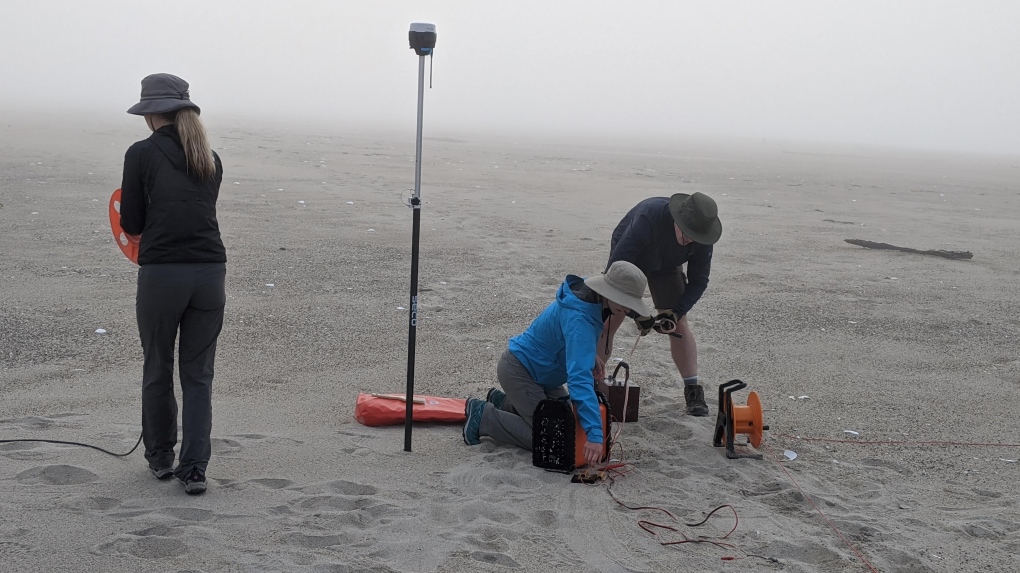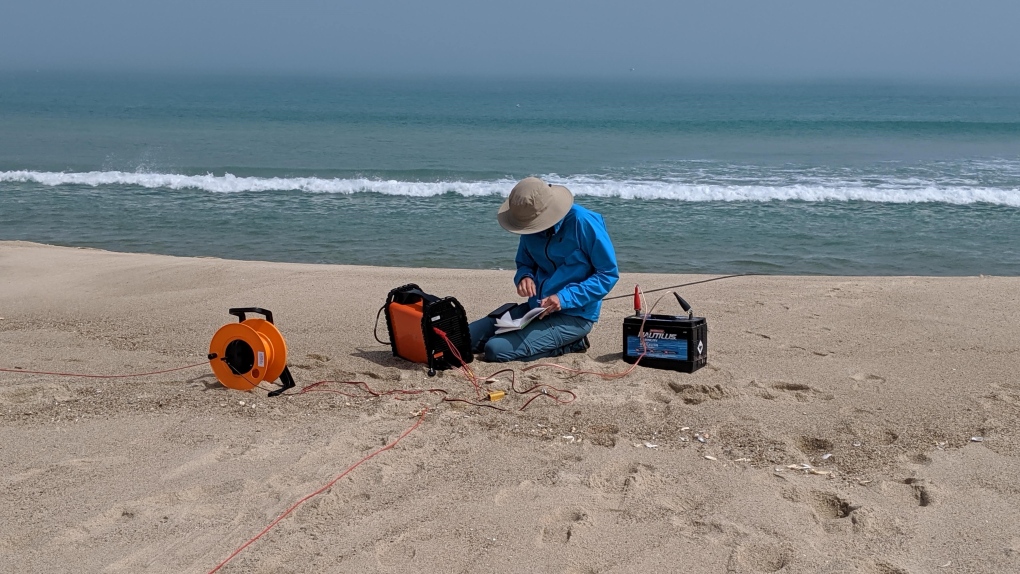Freshwater at risk: Dalhousie University research into precious resource on Sable Island
It may be surrounded by the Atlantic Ocean, but inland, there is fresh water on Nova Scotia’s Sable Island – ponds which provide drinking water for the Island’s diverse and unique wildlife, including its population of about 450 wild horses.
But new research from scientists with Dalhousie University’s Coastal Hydrology Lab suggests the groundwater supply is being threatened by changing weather and coastal erosion.
“There's historical ground water monitoring data on Sable Island,” explains PhD candidate Julia Cantelon, “and the goal of my work was to go back to the island and make repeat measurements to see if there had been change since the 1970s.”
The results of that work have been published in the October edition of the journal “Water Resources Research.”
Cantelon and study co-author Barret Kurylyk, the Canada Research Chair in Coastal Hydrology at Dalhousie, travelled with team members to the crescent-shaped island 190 kilometres off the coast several times to install and monitor sophisticated equipment which allowed them to “see” underground.
 Researchers set up equipment to measure if the groundwater supply at Sable Island is being threatened by changing weather and coastal erosion. (Courtesy: Dalhousie)That allowed them to find and measure freshwater and saltwater present on the island.
Researchers set up equipment to measure if the groundwater supply at Sable Island is being threatened by changing weather and coastal erosion. (Courtesy: Dalhousie)That allowed them to find and measure freshwater and saltwater present on the island.
Sable Island’s groundwater supply comes from rainfall that filters into a sand aquifer.
Their findings indicate that supply has been compromised in areas particularly on the south shore of the island where the iconic dunes have eroded, even as waves and powerful storms keep washing more saltwater in.
“In areas where the dunes were completely lost, we saw a complete loss of the fresh groundwater, a loss of up to 10 metres,” explains Cantelon.
 Researchers install equipment which allows them to "see" underground to allow them to measure freshwater and saltwater present on Sable Island. (Courtesy: Dalhousie)The ecosystem typically “flushes” the saltwater out, allowing the groundwater supply to recovery.
Researchers install equipment which allows them to "see" underground to allow them to measure freshwater and saltwater present on Sable Island. (Courtesy: Dalhousie)The ecosystem typically “flushes” the saltwater out, allowing the groundwater supply to recovery.
But Cantelon and Kurylyk say the increasing frequency and severity of hurricanes like Fiona last year are making that more difficult.
“These findings have some concern in terms of the trajectory, so (that) over time potentially the part of Sable Island that is eroding, could experience more and more saltwater intrusion into the coming decades,” says Kurylyk.
He says the work has implications not only for understanding the changes happening on Sable Island, but also for other islands and coastal communities around the world.
“People think about coastal erosion and surface flooding because…they can see it, but what happens in the subsurface is important too,” he explains.
“And so what Julia’s work shows is that over time, those changes at the surface, whether its coastal erosion or flooding or in combination, they can really drive profound and long-lasting subsurface changes to groundwater salinity,” Kurylyk says
“We can take those findings and apply them in other places where coastlines are changing, and so even here in Nova Scotia we have issues with saltwater intrusion into our coastal wells,” he adds.
Kurylyk and Cantelon say the research is also valuable for Parks Canada staff who live and work on the island, as they, too, rely on the groundwater supply for drinking water.
 Researchers set up equipment to measure is the groundwater supply at Sable Island is being threatened by changing weather and coastal erosion. (Courtesy: Dalhousie)Cantelon’s last trip to Sable Island is Thursday, where she will collect the team’s remaining instruments to officially wrap up the project. But she hopes there will be more work on the subject in the future.
Researchers set up equipment to measure is the groundwater supply at Sable Island is being threatened by changing weather and coastal erosion. (Courtesy: Dalhousie)Cantelon’s last trip to Sable Island is Thursday, where she will collect the team’s remaining instruments to officially wrap up the project. But she hopes there will be more work on the subject in the future.
“For the sake of the freshwater resources, I hope it will be an ongoing research relationship between the Lab and Parks Canada.”
For more Nova Scotia news visit our dedicated provincial page.
CTVNews.ca Top Stories

Poilievre to Trump: 'Canada will never be the 51st state'
Conservative leader Pierre Poilievre is responding to U.S. president-elect Donald Trump’s ongoing suggestions that Canada become the 51st state, saying it will 'never happen.'
WATCH LIVE 'I understand there's going to be a short runway,' new minister says after Trudeau shuffles cabinet
Prime Minister Justin Trudeau added eight Liberal MPs to his front bench and reassigned four ministers in a cabinet shuffle in Ottawa on Friday, but as soon as they were sworn-in, they faced questions about the political future of their government, and their leader.
Singh says the NDP 'will vote to bring this government down' in new letter
After months of being non-committal, in a new letter, NDP Leader Jagmeet Singh says his caucus 'will vote to bring this government down,' sometime in 2025.
Quebecer convicted of killing partner, two children sentenced
A Quebecer convicted in a triple murder on Montreal's South Shore has been sentenced to life in prison without chance of parole for 20 years in the second-degree death of Synthia Bussieres.
Guelph man facing assault charge after police say he spat in roommate's face during disagreement over cat
A fight between roommates has led to an assault charge for a Guelph man.
Joss Stone says she's discovered she's pregnant – just weeks after adopting a baby
Joss Stone has revealed that she is pregnant, just weeks after she and her husband adopted a baby boy.
A new book about Chrystia Freeland just came out. Here's what we learned
A new book about Chrystia Freeland has just come out, after the publishing company sped up its release date by a few months. CTV News sifted through the book and pulled out some notable anecdotes, as well as insights about Freeland's relationship with the prime minister.
Is the Norad Santa tracker safe from a U.S. government shutdown?
The military's tradition of tracking Santa Claus on his gravity-defying sweep across the globe will carry on this Christmas Eve, even if the U.S. government shuts down, officials said Friday.
U.S. recalls 600K car seats, fix available to Canadians
Nuna Baby Essentials is recalling nearly 609,000 child car seats because the harness adjuster can loosen and the seats may not restrain children.


































